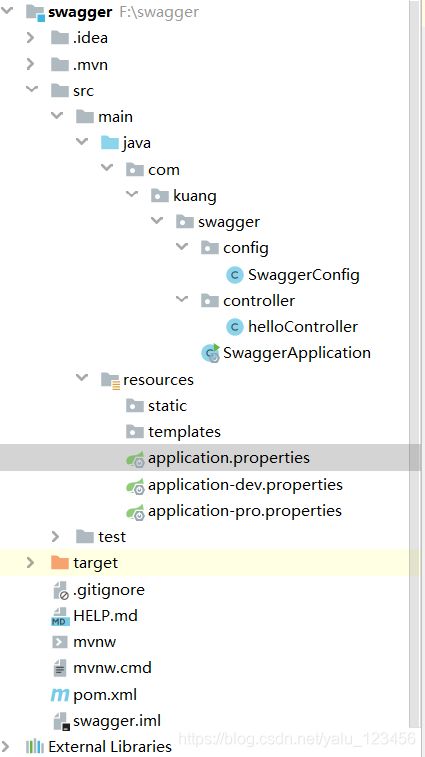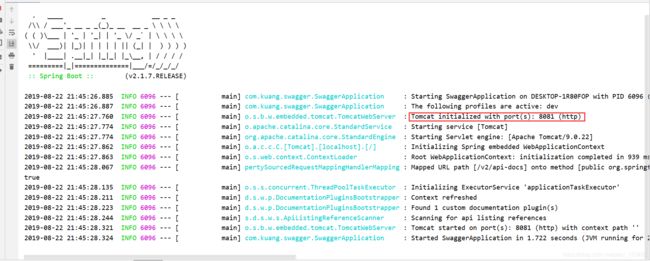Java框架之swagger学习及使用
Swagger简介
前后端分离
Vue + SpringBoot
后端时代:前端只用管理静态页面;html==> 后端。模板引擎 JSP =>后端是主力
前后端分离式时代:
- 后端 :后端控制层,服务层,数据访问层 【后端团队】
- 前端 :前端控制层,视图层 【前端团队】
- 伪造后端数据,json。已经存在了,不需要后端,前端工程依旧能够跑起来
- 前端后如何交互 ? ===> API
- 前后端相对独立,松耦合;
- 前后端甚至可以部署在不同的服务器上;
产生一个问题:
- 前后端集成联调,前端人员和后端人员无法做到 “即使协商, 尽早解决”,最终导致问题集中爆发;
解决方案:
- 首先指定schema[计划的提纲],实时更新最新API,降低集成的风险;
- 早些年:指定word计划文档;
- 前后端分离:
- 前端测试后端接口:postman
- 后端提供接口,需要实时更新最新的消息及改动!
Swagger特点
- 号称世界上最流行的Api框架;
- RestFul Api 文档在线自动生成工具=>Api文档与API定义同步更新
- 直接运行,可以在线测试API接口;
- 支持多种语言:(Java,Php…)
官网:[https://swagger.io/
SpringBoot 集成Swagger的使用
在项目使用Swagger需要 springbox;
-
新建一个SpringBoot 的web项目
-
导入相关依赖
io.springfox
springfox-swagger2
2.9.2
io.springfox
springfox-swagger-ui
2.9.2
- 编写一个Hello工程
helloController文件编写:
package com.kuang.swagger.controller;
import org.springframework.web.bind.annotation.RequestMapping;
import org.springframework.web.bind.annotation.RestController;
import java.sql.SQLOutput;
@RestController
public class helloController {
@RequestMapping("/hello")
public String hello(){
return "hello";
}
}
- 配置Swagger ==> Config
@Configuration //相当于component
@EnableSwagger2 //开启Swagger2
public class SwaggerConfig {
}
- 测试运行:http://localhost:8080/swagger-ui.html
配置Swagger信息
package com.kuang.swagger.config;
import org.springframework.context.annotation.Bean;
import org.springframework.context.annotation.Configuration;
import org.springframework.core.env.Environment;
import org.springframework.core.env.Profiles;
import springfox.documentation.builders.PathSelectors;
import springfox.documentation.builders.RequestHandlerSelectors;
import springfox.documentation.service.ApiInfo;
import springfox.documentation.service.Contact;
import springfox.documentation.spi.DocumentationType;
import springfox.documentation.spring.web.plugins.Docket;
import springfox.documentation.swagger2.annotations.EnableSwagger2;
import java.util.ArrayList;
@Configuration
@EnableSwagger2
public class SwaggerConfig {
@Bean
public Docket docket(){
return new Docket(DocumentationType.SWAGGER_2).apiInfo(apiInfo());
}
// 配置swagger信息
private ApiInfo apiInfo() {
Contact contact = new Contact("小明", "https://blog.csdn.net/yalu_123456", "8718*****@qq.com");
return new ApiInfo("yalu 的api文档",
"感谢现在努力的自己",
"v1.0",
"https://blog.csdn.net/yalu_123456",
contact,
"apache2.0",
"http://www.apache.org/licenses/LICENSE-2.0",
new ArrayList());
}
}
Swagger配置扫描接口
swiggerconfig类:
@Configuration
@EnableSwagger2
public class SwaggerConfig {
// @Bean
// public Docket docket(){
// return new Docket(DocumentationType.SWAGGER_2).apiInfo(apiInfo());
// }
//配置了Swagger的Docket的bean实例
@Bean
public Docket docket() {
return new Docket(DocumentationType.SWAGGER_2)
.apiInfo(apiInfo())
.select()
//RequestHandlerSelectors,配置要扫描接口的方式
//basePackage:指定要扫描的包
//any():扫描全部
//none():不扫描
//withClassAnnotation:扫描类上的注解,参数是一个注解的反射对象
//withMethodAnnotation:扫描方法上的注解
.apis(RequestHandlerSelectors.basePackage("com.kuang.swagger.controller"))
//paths()。过滤什么路径
.paths(PathSelectors.ant("/kuang/**"))
.build();
}
// 配置swagger信息
private ApiInfo apiInfo() {
Contact contact = new Contact("小明", "https://blog.csdn.net/yalu_123456", "8718*****@qq.com");
return new ApiInfo("yalu 的api文档",
"感谢现在努力的自己",
"v1.0",
"https://blog.csdn.net/yalu_123456",
contact,
"apache2.0",
"http://www.apache.org/licenses/LICENSE-2.0",
new ArrayList());
}
}
测试结果:

这里我们可以看到经过.paths(PathSelectors.ant("/kuang/**"))过滤之后我们无法看到controller相关内容
配置是否启动Swagger
同样修改swaggerconfig类
@Bean
public Docket docket(){
return new Docket(DocumentationType.SWAGGER_2)
.apiInfo(apiInfo())
.enable(false)//enable是否启动Swagger,如果为False,则Swagger不能再浏览器中访问
.select()
.apis(RequestHandlerSelectors.basePackage("com.kuang.swagger.controller"))
//.paths(PathSelectors.ant("/kuang/**"))
.build();
}
// 配置swagger信息
private ApiInfo apiInfo() {
Contact contact = new Contact("小明", "https://blog.csdn.net/yalu_123456", "8718*****@qq.com");
return new ApiInfo("yalu 的api文档",
"感谢现在努力的自己",
"v1.0",
"https://blog.csdn.net/yalu_123456",
contact,
"apache2.0",
"http://www.apache.org/licenses/LICENSE-2.0",
new ArrayList());
}
.enable(false)//enable是否启动Swagger,如果为False,则Swagger不能再浏览器中访问
在特定环境下使用swagger
我只希望我的Swagger在生产环境中使用,在发布的时候不使用?
- 判断是不是生产环境 flag = false
- 注入enable(flag)
同样我们需要修改swagger类:
//配置了Swagger的Docket的bean实例
@Bean
public Docket docket(Environment environment){
//设置要显示的Swagger环境
Profiles profiles = Profiles.of("dev","test");
//通过environment.acceptsProfiles判断是否处在自己设定的环境当中
boolean flag = environment.acceptsProfiles(profiles);
System.out.println(flag);
return new Docket(DocumentationType.SWAGGER_2)
.apiInfo(apiInfo())
.enable(flag)//enable是否启动Swagger,如果为False,则Swagger不能再浏览器中访问
.select()
.apis(RequestHandlerSelectors.basePackage("com.kuang.swagger.controller"))
//.paths(PathSelectors.ant("/kuang/**"))
.build();
}
// 配置swagger信息
private ApiInfo apiInfo() {
Contact contact = new Contact("小明", "https://blog.csdn.net/yalu_123456", "8718*****@qq.com");
return new ApiInfo("yalu 的api文档",
"感谢现在努力的自己",
"v1.0",
"https://blog.csdn.net/yalu_123456",
contact,
"apache2.0",
"http://www.apache.org/licenses/LICENSE-2.0",
new ArrayList());
}
application.properties
spring.profiles.active=pdiv
applicaton-devproperties
server.port=8081
application-pro.peoperties
server.port=8082
这里我们需要注意
//设置要显示的Swagger环境
Profiles profiles = Profiles.of(“dev”,“test”);
这里我们设置了两个字段“dev”和“test”,这里只要是application.properties文件中激活的字段都可以使用swagger,不过需要特别注意访问的端口号!!!(容易入坑)
我们现在来测试下:
配置API文档的分组
只要我们的接口中,返回值中存在实体类,他就会被扫描到Swagger中
实体类:
package com.kuang.swagger.pojo;
import io.swagger.annotations.Api;
import io.swagger.annotations.ApiModel;
import io.swagger.annotations.ApiModelProperty;
//@Api(注释)
@ApiModel("用户实体类")
public class User {
@ApiModelProperty("用户名")
public String username;
@ApiModelProperty("密码")
public String password;
}
controller:
package com.kuang.swagger.controller;
import com.kuang.swagger.pojo.User;
import io.swagger.annotations.ApiOperation;
import io.swagger.annotations.ApiParam;
import org.springframework.web.bind.annotation.GetMapping;
import org.springframework.web.bind.annotation.PostMapping;
import org.springframework.web.bind.annotation.RequestMapping;
import org.springframework.web.bind.annotation.RestController;
import java.sql.SQLOutput;
@RestController
public class helloController {
@RequestMapping("/hello")
public String hello(){
return "hello";
}
//只要我们的接口中,返回值中存在实体类,他就会被扫描到Swagger中
@PostMapping(value = "/user")
public User user(){
return new User();
}
//Operation接口,不是放在类上的,是方法
@ApiOperation("Hello控制类")
@GetMapping(value = "/hello2")
public String hello2(@ApiParam("用户名") String username){
return "hello"+username;
}
@ApiOperation("Post测试类")
@PostMapping(value = "/postt")
public User postt(@ApiParam("用户名") User user){
int i = 5;
return user;
}
}
总结
- 我们可以通过Swagger给一些比较难理解的属性或者接口,增加注释信息
- 接口文档实时更新
- 可以在线测试
Swagger是一个优秀的工具,几乎所有大公司都有使用它
【注意点】在正式发布的时候,关闭Swagger!!!出于安全考虑。而且节省运行的内存;













